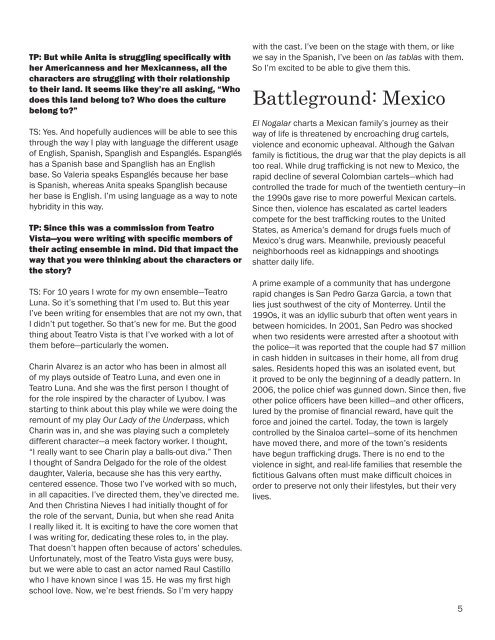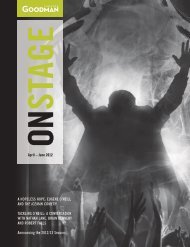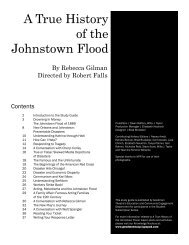El Nogalar Study Guide (9MB) - Goodman Theatre
El Nogalar Study Guide (9MB) - Goodman Theatre
El Nogalar Study Guide (9MB) - Goodman Theatre
Create successful ePaper yourself
Turn your PDF publications into a flip-book with our unique Google optimized e-Paper software.
TP: But while Anita is struggling specifically with<br />
her Americanness and her Mexicanness, all the<br />
characters are struggling with their relationship<br />
to their land. It seems like they’re all asking, “Who<br />
does this land belong to? Who does the culture<br />
belong to?”<br />
TS: Yes. And hopefully audiences will be able to see this<br />
through the way I play with language the different usage<br />
of English, Spanish, Spanglish and Espanglés. Espanglés<br />
has a Spanish base and Spanglish has an English<br />
base. So Valeria speaks Espanglés because her base<br />
is Spanish, whereas Anita speaks Spanglish because<br />
her base is English. I’m using language as a way to note<br />
hybridity in this way.<br />
TP: Since this was a commission from Teatro<br />
Vista—you were writing with specific members of<br />
their acting ensemble in mind. Did that impact the<br />
way that you were thinking about the characters or<br />
the story?<br />
TS: For 10 years I wrote for my own ensemble—Teatro<br />
Luna. So it’s something that I’m used to. But this year<br />
I’ve been writing for ensembles that are not my own, that<br />
I didn’t put together. So that’s new for me. But the good<br />
thing about Teatro Vista is that I’ve worked with a lot of<br />
them before—particularly the women.<br />
Charin Alvarez is an actor who has been in almost all<br />
of my plays outside of Teatro Luna, and even one in<br />
Teatro Luna. And she was the first person I thought of<br />
for the role inspired by the character of Lyubov. I was<br />
starting to think about this play while we were doing the<br />
remount of my play Our Lady of the Underpass, which<br />
Charin was in, and she was playing such a completely<br />
different character—a meek factory worker. I thought,<br />
“I really want to see Charin play a balls-out diva.” Then<br />
I thought of Sandra Delgado for the role of the oldest<br />
daughter, Valeria, because she has this very earthy,<br />
centered essence. Those two I’ve worked with so much,<br />
in all capacities. I’ve directed them, they’ve directed me.<br />
And then Christina Nieves I had initially thought of for<br />
the role of the servant, Dunia, but when she read Anita<br />
I really liked it. It is exciting to have the core women that<br />
I was writing for, dedicating these roles to, in the play.<br />
That doesn’t happen often because of actors’ schedules.<br />
Unfortunately, most of the Teatro Vista guys were busy,<br />
but we were able to cast an actor named Raul Castillo<br />
who I have known since I was 15. He was my first high<br />
school love. Now, we’re best friends. So I’m very happy<br />
with the cast. I’ve been on the stage with them, or like<br />
we say in the Spanish, I’ve been on las tablas with them.<br />
So I’m excited to be able to give them this.<br />
Battleground: Mexico<br />
<strong>El</strong> <strong>Nogalar</strong> charts a Mexican family’s journey as their<br />
way of life is threatened by encroaching drug cartels,<br />
violence and economic upheaval. Although the Galvan<br />
family is fictitious, the drug war that the play depicts is all<br />
too real. While drug trafficking is not new to Mexico, the<br />
rapid decline of several Colombian cartels—which had<br />
controlled the trade for much of the twentieth century—in<br />
the 1990s gave rise to more powerful Mexican cartels.<br />
Since then, violence has escalated as cartel leaders<br />
compete for the best trafficking routes to the United<br />
States, as America’s demand for drugs fuels much of<br />
Mexico’s drug wars. Meanwhile, previously peaceful<br />
neighborhoods reel as kidnappings and shootings<br />
shatter daily life.<br />
A prime example of a community that has undergone<br />
rapid changes is San Pedro Garza Garcia, a town that<br />
lies just southwest of the city of Monterrey. Until the<br />
1990s, it was an idyllic suburb that often went years in<br />
between homicides. In 2001, San Pedro was shocked<br />
when two residents were arrested after a shootout with<br />
the police—it was reported that the couple had $7 million<br />
in cash hidden in suitcases in their home, all from drug<br />
sales. Residents hoped this was an isolated event, but<br />
it proved to be only the beginning of a deadly pattern. In<br />
2006, the police chief was gunned down. Since then, five<br />
other police officers have been killed—and other officers,<br />
lured by the promise of financial reward, have quit the<br />
force and joined the cartel. Today, the town is largely<br />
controlled by the Sinaloa cartel—some of its henchmen<br />
have moved there, and more of the town’s residents<br />
have begun trafficking drugs. There is no end to the<br />
violence in sight, and real-life families that resemble the<br />
fictitious Galvans often must make difficult choices in<br />
order to preserve not only their lifestyles, but their very<br />
lives.<br />
5<br />
<strong>El</strong><strong>Nogalar</strong>.indd 5<br />
3/25/2011 4:05:32 PM
















